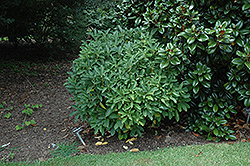It's all about ...
plants

Height: 4 feet
Spread: 6 feet
Sunlight:
![]()
![]()
Hardiness Zone: 7b
Description:
An interesting shrub for shady areas of the garden, or as an understory plant in a wooded area; great for containers in shady patio areas
Ornamental Features
Daphniphyllum has emerald green deciduous foliage on a plant with a round habit of growth. The narrow leaves turn yellow in fall. The fruits are showy black drupes displayed in mid summer.
Landscape Attributes
Daphniphyllum is a multi-stemmed deciduous shrub with a more or less rounded form. Its average texture blends into the landscape, but can be balanced by one or two finer or coarser trees or shrubs for an effective composition.
This is a relatively low maintenance shrub, and should only be pruned after flowering to avoid removing any of the current season's flowers. Deer don't particularly care for this plant and will usually leave it alone in favor of tastier treats. It has no significant negative characteristics.
Daphniphyllum is recommended for the following landscape applications;
- Mass Planting
- General Garden Use
- Container Planting
Planting & Growing
Daphniphyllum will grow to be about 4 feet tall at maturity, with a spread of 6 feet. It has a low canopy. It grows at a slow rate, and under ideal conditions can be expected to live for approximately 30 years.
This shrub does best in partial shade to shade. It does best in average to evenly moist conditions, but will not tolerate standing water. It is not particular as to soil pH, but grows best in rich soils. It is somewhat tolerant of urban pollution, and will benefit from being planted in a relatively sheltered location. Consider applying a thick mulch around the root zone in winter to protect it in exposed locations or colder microclimates. This species is not originally from North America.
Daphniphyllum makes a fine choice for the outdoor landscape, but it is also well-suited for use in outdoor pots and containers. Because of its height, it is often used as a 'thriller' in the 'spiller-thriller-filler' container combination; plant it near the center of the pot, surrounded by smaller plants and those that spill over the edges. It is even sizeable enough that it can be grown alone in a suitable container. Note that when grown in a container, it may not perform exactly as indicated on the tag - this is to be expected. Also note that when growing plants in outdoor containers and baskets, they may require more frequent waterings than they would in the yard or garden. Be aware that in our climate, most plants cannot be expected to survive the winter if left in containers outdoors, and this plant is no exception. Contact our experts for more information on how to protect it over the winter months.
This plant is not reliably hardy in our region, and certain restrictions may apply; contact the store for more information.
